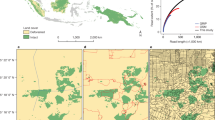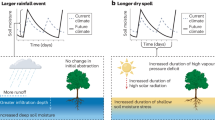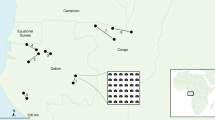Abstract
Across the tropics, recent agricultural shifts have led to a rapid expansion of tree plantations, often into intact forests and grasslands. However, this expansion is poorly characterized. Here, we report tropical tree plantation expansion between 2000 and 2012, based on classifying nearly 7 million unique patches of observed tree cover gain using optical and radar satellite imagery. The resulting map was a subsample of all tree cover gain but we coupled it with an extensive random accuracy assessment (n = 4,269 points) to provide unbiased estimates of expansion. Most predicted gain patches (69.2%) consisted of small patches of natural regrowth (31.6 ± 11.9 Mha). However, expansion of tree plantations also dominated increases in tree cover across the tropics (32.2 ± 9.4 Mha) with 92% of predicted plantation expansion occurring in biodiversity hotspots and 14% in arid biomes. We estimate that tree plantations expanded into 9.2% of accessible protected areas across the humid tropics, most frequently in southeast Asia, west Africa and Brazil. Given international tree planting commitments, it is critical to understand how future tree plantation expansion will affect remaining natural ecosystems.
This is a preview of subscription content, access via your institution
Access options
Access Nature and 54 other Nature Portfolio journals
Get Nature+, our best-value online-access subscription
$29.99 / 30 days
cancel any time
Subscribe to this journal
Receive 12 digital issues and online access to articles
$119.00 per year
only $9.92 per issue
Buy this article
- Purchase on Springer Link
- Instant access to full article PDF
Prices may be subject to local taxes which are calculated during checkout



Similar content being viewed by others
Data availability
All data needed to replicate our results are available in the article, online or the supplementary information. Manually generated training data are available from the corresponding author, M.E.F., upon reasonable request. Predicted map outputs can be downloaded from the Global Forest Watch data repository: https://data.globalforestwatch.org/content/pantropical-tree-plantation-expansion-2000-2012/about
Code availability
All Python code needed to replicate our input data from Google Earth Engine are available on github at https://github.com/dohyung-kim/plantation. All R code for data analysis are available from the corresponding author, M.E.F., upon reasonable request, with the main R scripts available on github.
References
Curtis, P. G., Slay, C. M., Harris, N. L., Tyukavina, A. & Hansen, M. C. Classifying drivers of global forest loss. Science 361, 1108–1111 (2018).
Gibbs, H. K. et al. Tropical forests were the primary sources of new agricultural land in the 1980s and 1990s. Proc. Natl Acad. Sci. USA 107, 16732–16737 (2010).
Payn, T. et al. Changes in planted forests and future global implications. Ecol. Manag. 352, 57–67 (2015).
Pendrill, F., Persson, U. M., Godar, J. & Kastner, T. Deforestation displaced: trade in forest-risk commodities and the prospects for a global forest transition. Environ. Res. Lett. 14, 055003 (2019).
Hurni, K. & Fox, J. The expansion of tree-based boom crops in mainland Southeast Asia: 2001 to 2014. J. Land Use Sci. 13, 198–219 (2018).
Vijay, V. et al. The impacts of oil palm on recent deforestation and biodiversity loss. PLoS ONE 11, e0159668 (2016).
Heilmayr, R., Echeverría, C. & Lambin, E. F. Impacts of Chilean forest subsidies on forest cover, carbon and biodiversity. Nat. Sustain. 3, 701–709 (2020).
le Maire, G., Dupuy, S., Nouvellon, Y., Loos, R. A. & Hakamada, R. Mapping short-rotation plantations at regional scale using MODIS time series: case of eucalypt plantations in Brazil. Remote Sens. Environ. 152, 136–149 (2014).
Wang, M. M. H., Carrasco, L. R. & Edwards, D. P. Reconciling rubber expansion with biodiversity conservation. Curr. Biol. 30, 3825–3832 (2020).
Lewis, S. L., Wheeler, C. E., Mitchard, E. T. A. & Koch, A. Restoring natural forests is the best way to remove atmospheric carbon. Nature 568, 25–28 (2019).
Dave, R. et al. Second Bonn Challenge Progress Report: Application of the Barometer in 2018 (IUCN, 2019).
Sloan, S., Meyfroidt, P., Rudel, T. K., Bongers, F. & Chazdon, R. The forest transformation: planted tree cover and regional dynamics of tree gains and losses. Glob. Environ. Change 59, 101988 (2019).
Petersen, R. et al. Mapping Tree Plantations with Multispectral Imagery: Preliminary Results for Seven Tropical Countries (WRI, 2016).
Erb, K.-H. et al. Land management: data availability and process understanding for global change studies. Glob. Change Biol. 23, 512–533 (2017).
Souza, C. M. et al. Reconstructing three decades of land use and land cover changes in Brazilian biomes with Landsat Archive and Earth Engine. Remote Sens. 12, 2735 (2020).
Miettinen, J. et al. Extent of industrial plantations on Southeast Asian peatlands in 2010 with analysis of historical expansion and future projections. GCB Bioenergy 4, 908–918 (2012).
Vancutsem, C. et al. Long-term (1990–2019) monitoring of forest cover changes in the humid tropics. Sci. Adv. 7, eabe1603 (2021).
Puyravaud, J.-P., Davidar, P. & Laurance, W. F. Cryptic destruction of India’s native forests. Conserv. Lett. 3, 390–394 (2010).
Fagan, M. E. et al. Mapping pine plantations in the southeastern U.S. using structural, spectral, and temporal remote sensing data. Remote Sens. Environ. 216, 415–426 (2018).
Tropek, R. et al. Comment on “High-resolution global maps of 21st-century forest cover change”. Science 344, 981 (2014).
Global Forest Resources Assessment 2020 (FAO, 2020).
FAOSTAT Agricultural Statistics Database (FAO, 2019); http://faostat.fao.org/site/291/default.aspx
Cook-Patton, S. C. et al. Mapping carbon accumulation potential from global natural forest regrowth. Nature 585, 545–550 (2020).
Hurni, K., Schneider, A., Heinimann, A., Nong, D. H. & Fox, J. Mapping the expansion of boom crops in mainland Southeast Asia using dense time stacks of Landsat data. Remote Sens. 9, 320 (2017).
Miettinen, J., Shi, C. & Liew, S. C. 2015 Land cover map of Southeast Asia at 250 m spatial resolution. Remote Sens. Lett. 7, 701–710 (2016).
Torbick, N., Ledoux, L., Salas, W. & M. Zhao, M. Regional mapping of plantation extent using multisensor imagery. Remote Sens. 8, 236 (2016).
Azizan, F. A., Kiloes, A. M., Astuti, I. S. & Abdul Aziz, A. Application of optical remote sensing in rubber plantations: a systematic review. Remote Sens. 13, 429 (2021).
Bégué, A. et al. Remote sensing and cropping practices: a review. Remote Sens. 10, 99 (2018).
Bey, A. & Meyfroidt, P. Improved land monitoring to assess large-scale tree plantation expansion and trajectories in Northern Mozambique. Environ. Res. Commun. 3, 115009 (2021).
Jucker, T. et al. Topography shapes the structure, composition and function of tropical forest landscapes. Ecol. Lett. 21, 989–1000 (2018).
Féret, J.-B. & Asner, G. P. Spectroscopic classification of tropical forest species using radiative transfer modeling. Remote Sens. Environ. 115, 2415–2422 (2011).
Poortinga, A. et al. Mapping plantations in Myanmar by fusing Landsat-8, Sentinel-2 and Sentinel-1 data along with systematic error quantification. Remote Sens. 11, 831 (2019).
Gutiérrez-Vélez, V. H. et al. High-yield oil palm expansion spares land at the expense of forests in the Peruvian Amazon. Environ. Res. Lett. 6, 044029 (2011).
Descals, A. et al. High-resolution global map of smallholder and industrial closed-canopy oil palm plantations. Earth Syst. Sci. Data. 13, 1211–1231 (2021).
Ordway, E. M., Naylor, R. L., Nkongho, R. N. & Lambin, E. F. Oil palm expansion and deforestation in Southwest Cameroon associated with proliferation of informal mills. Nat. Commun. 10, 114 (2019).
Heilmayr, R., Echeverría, C., Fuentes, R. & Lambin, E. F. A plantation-dominated forest transition in Chile. Appl. Geogr. 75, 71–82 (2016).
Hansen, M. C. et al. High-resolution global maps of 21st-century forest cover change. Science 342, 850–853 (2013).
Bond, W. J., Stevens, N., Midgley, G. F. & Lehmann, C. E. R. The trouble with trees: afforestation plans for Africa. Trends Ecol. Evol. 34, 963–965 (2019).
Veldman, J. W. et al. Where tree planting and forest expansion are bad for biodiversity and ecosystem services. Bioscience 65, 1011–1018 (2015).
Venter, O. et al. Global terrestrial Human Footprint maps for 1993 and 2009. Sci. Data 3, 160067 (2016).
Fagan, M. E. A lesson unlearned? Underestimating tree cover in drylands biases global restoration maps. Glob. Change Biol. 26, 4679–4690 (2020).
Bastin, J. F. et al. The extent of forest in dryland biomes. Science 356, 635–638 (2017).
Fagan, M. E., Reid, J. L., Holland, M. B., Drew, J. G. & Zahawi, R. A. How feasible are global forest restoration commitments? Conserv. Lett. 13, e12700 (2020).
Malkamäki, A. et al. A systematic review of the socio-economic impacts of large-scale tree plantations, worldwide. Glob. Environ. Change 53, 90–103 (2018).
Schwartz, N. B., Aide, T. M., Graesser, J., Grau, H. R. & Uriarte, M. Reversals of reforestation across Latin America limit climate mitigation potential of tropical forests. Front. For. Glob. Change 3, 85 (2020).
Noojipady, P. et al. Managing fire risk during drought: the influence of certification and El Niño on fire-driven forest conversion for oil palm in Southeast Asia. Earth Syst. Dynam. 8, 749–771 (2017).
Bullock, E. L., Woodcock, C. E., Souza, C. Jr. & Olofsson, P. Satellite-based estimates reveal widespread forest degradation in the Amazon. Glob. Change Biol. 26, 2956–2969 (2020).
Sloan, S. & Sayer, J. A. Forest Ecology and Management Forest Resources Assessment of 2015 shows positive global trends but forest loss and degradation persist in poor tropical countries. Ecol. Manag. 352, 134–145 (2015).
Heinrich, V. H. A. et al. Large carbon sink potential of secondary forests in the Brazilian Amazon to mitigate climate change. Nat. Commun. 12, 1785 (2021).
Potapov, P. et al. Mapping global forest canopy height through integration of GEDI and Landsat data. Remote Sens. Environ. 253, 112165 (2021).
Bernal, B., Murray, L. T. & Pearson, T. R. H. Global carbon dioxide removal rates from forest landscape restoration activities. Carbon Balance Manag. 13, 22 (2018).
Li, W., Goodchild, M. F. & Church, R. An efficient measure of compactness for two-dimensional shapes and its application in regionalization problems. Int. J. Geogr. Inf. Sci. 27, 1227–1250 (2013).
Asner, G. P. Cloud cover in Landsat observations of the Brazilian Amazon. Int. J. Remote Sens. 22, 3855–3862 (2001).
Wilson, A. M. & Jetz, W. Remotely sensed high-resolution global cloud dynamics for predicting ecosystem and biodiversity distributions. PLoS Biol. 14, e1002415 (2016).
Gutiérrez-Vélez, V. H. & DeFries, R. Annual multi-resolution detection of land cover conversion to oil palm in the Peruvian Amazon. Remote Sens. Environ. 129, 154–167 (2013).
Reiche, J. et al. Combining satellite data for better tropical forest monitoring. Nat. Clim. Change 6, 120–122 (2016).
Erinjery, J. J., Singh, M. & Kent, R. Mapping and assessment of vegetation types in the tropical rainforests of the Western Ghats using multispectral Sentinel-2 and SAR Sentinel-1 satellite imagery. Remote Sens. Environ. 216, 345–354 (2018).
Shimada, M. et al. New global forest/non-forest maps from ALOS PALSAR data (2007–2010). Remote Sens. Environ. 155, 13–31 (2014).
Torres, R. et al. GMES Sentinel-1 mission. Remote Sens. Environ. 120, 9–24 (2012).
Potapov, P. et al. The last frontiers of wilderness: tracking loss of intact forest landscapes from 2000 to 2013. Sci. Adv. 3, e1600821 (2017).
World Database on Protected Areas User Manual 1.4 (UNEP-WCMC, 2016).
AutoML: Automatic Machine Learning (H2O.ai, 2020); https://h2o-release.s3.amazonaws.com/h2o/rel-yau/5/docs-website/h2o-docs/automl.html
Healey, S. P. et al. Mapping forest change using stacked generalization: an ensemble approach. Remote Sens. Environ. 204, 717–728 (2018).
Lagomasino, D. et al. Measuring mangrove carbon loss and gain in deltas. Environ. Res. Lett. 14, 25002 (2019).
Bunting, P. et al. The global mangrove watch—a new 2010 global baseline of mangrove extent. Remote Sens. 10, 1669 (2018).
Pickens, A. H. et al. Mapping and sampling to characterize global inland water dynamics from 1999 to 2018 with full Landsat time-series. Remote Sens. Environ. 243, 111792 (2020).
Olofsson, P. et al. Good practices for estimating area and assessing accuracy of land change. Remote Sens. Environ. 148, 42–57 (2014).
Stehman, S. V. Estimating area and map accuracy for stratified random sampling when the strata are different from the map classes. Int. J. Remote Sens. 35, 4923–4939 (2014).
Olofsson, P. et al. Mitigating the effects of omission errors on area and area change estimates. Remote Sens. Environ. 236, 111492 (2020).
Database of Global Administrative Areas (GADM) v.3.6 (GADM, 2018); https://gadm.org/download_country_v3.html
Hijmans, R. J., Williams, E., Vennes, C. M. & Hijmans, M. R. J. Package ‘geosphere’ version 1.5-10. Spherical trigonometry (2017).
Olson, D. M. et al. Terrestrial ecoregions of the world: a new map of life on Earth: a new global map of terrestrial ecoregions provides an innovative tool for conserving biodiversity. Bioscience 51, 933–938 (2001).
Mittermeier, R. A., Turner, W. R., Larsen, F. W., Brooks, T. M. & Gascon, C. in Biodiversity Hotspots: Distribution and Protection of Conservation Priority Areas (eds Zachos, F. E. & Habel, J. C.) 3–22 (Springer, 2011).
Potapov, P. et al. The last frontiers of wilderness: tracking loss of intact forest landscapes from 2000 to 2013. Sci. Adv. 3, e1600821 (2017).
Acknowledgements
We thank R. L. Chazdon, R. Crouzeilles, H. L. Beyer, B. C. Tice, S. Stehman and D. Lagomasino for their contributions to this project’s development. This research was supported by the National Aeronautics and Space Administration under grant no. 80NSSC21K0297.
Author information
Authors and Affiliations
Contributions
M.E.F. and D.H.K. were responsible for conceptualization and formal analysis. M.E.F. undertook visualization, project administration and supervision. M.E.F., D.H.K. and A.T. developed the methodology. M.E.F., L.F., J.D., H.C., W.S., J. Slaughter, J. Schaferbien and A.T. conducted validation. N.L.H., E.G. and E.M.O. provided resources (datasets). M.E.F., D.H.K., N.L.H., A.T., E.G. and E.M.O. were responsible for writing.
Corresponding author
Ethics declarations
Competing interests
The authors declare no competing interests.
Peer review
Peer review information
Nature Sustainability thanks Sean Sloan and the other, anonymous, reviewer(s) for their contribution to the peer review of this work.
Additional information
Publisher’s note Springer Nature remains neutral with regard to jurisdictional claims in published maps and institutional affiliations.
Supplementary information
Supplementary Information
Supplementary Methods, Results, Figs. 1–13 and Tables 1–15.
Supplementary Data 1
The testing data used to assess model predictive accuracy is enclosed (“NatureSust_Fagan_test_fin_111520_allC_locsXY_selected2.csv”). The format is a comma-separated text data table (n = 2,000); because some large polygons were sampled more than once, there are only 1,881 unique rows. See the notes column for column name explanations; the X and Y columns describe the patch polygon centroids. The full polygons were used to assess accuracy. The vector polygon boundaries are available from the corresponding author upon request.
Supplementary Data 2
The independent map accuracy assessment data is enclosed (“strRandSampRef_allJoinALL_v5fBCGsel_NatureSustSuppData.csv”). The format is a comma-separated text data table (n = 4,269), with each row representing a stratified random point location. See the description column for column name explanations.
Supplementary Data 3
The land cover class conversion table used to reclassify the TMF map product to match our reference data is enclosed (“Reclass_moist_forest_analysis3_NatSustainSuppData.csv”). The format is a comma-separated text data table, with each row representing a TMF land cover transition class subtype. See the notes column for column name explanations.
Supplementary Data 4
The comparative accuracy assessment data used to assess the GFC and TMF map products across the humid biome is enclosed (“pointsAccA_selectedHansenTMF_fin_NatSustainSuppData.csv”). The format is a comma-separated text data table (n = 2,691), with each row representing a random point location. See the notes column for column name explanations.
Rights and permissions
About this article
Cite this article
Fagan, M.E., Kim, DH., Settle, W. et al. The expansion of tree plantations across tropical biomes. Nat Sustain 5, 681–688 (2022). https://doi.org/10.1038/s41893-022-00904-w
Received:
Accepted:
Published:
Issue Date:
DOI: https://doi.org/10.1038/s41893-022-00904-w
This article is cited by
-
Quantifying forest degradation requires a long-term, landscape-scale approach
Nature Ecology & Evolution (2024)
-
Trees on smallholder farms and forest restoration are critical for Rwanda to achieve net zero emissions
Communications Earth & Environment (2024)
-
Long-Term Effects of Ecological Restoration Projects on Ecosystem Services and Their Spatial Interactions: A Case Study of Hainan Tropical Forest Park in China
Environmental Management (2024)
-
Community forest governance and synergies among carbon, biodiversity and livelihoods
Nature Climate Change (2023)
-
Forest regrowth improves people’s dietary quality in Nigeria
npj Sustainable Agriculture (2023)



